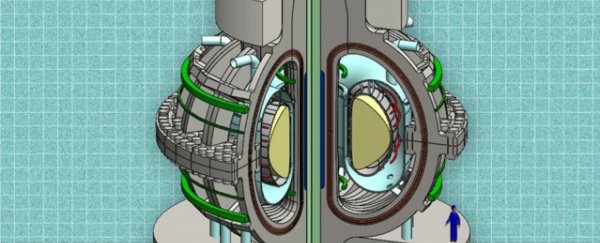Scientists at Massachusetts Institute for Technology (MIT) in the US have designed a 6.6-metre-wide fusion reactor that they say could provide electricity to around 100,000 people. Even better, it could be up and running within 10 years, according to their calculations.
For decades, scientists have been trying to find a way to harness nuclear fusion - the reaction that powers stars - because of its ability to produce almost-unlimited energy supplies using little more than seawater, and without emitting greenhouse gasses. But despite many promising designs, finding a way to contain and commercialise the reaction on Earth has proven far more challenging than imagined. In fact it's a long-running joke among scientists that practical nuclear fusion power plants are just 30 years away - and always will be.
But not only does the new MIT design promise to be cheaper and smaller than current reactors, it also provides hope that commercial nuclear fusion reactors could become a reality in our lifetime, with the team explaining that similar devices in size and complexity have taken just five years to build.
"Fusion energy is certain to be the most important source of electricity on Earth in the 22nd century, but we need it much sooner than that to avoid catastrophic global warming," David Kingham, a UK-based nuclear fusion expert who wasn't involved in the research, told David L. Chandler from the MIT news office. "This paper shows a good way to make quicker progress."
To explain it very simply, nuclear fusion relies on fusing hydrogen atoms together at super-high temperatures to release enormous amounts of energy. This is different to the nuclear fission used in nuclear power plants, which is where scientists split atoms to generate electricity - a process that's less stable and also produces large amounts of nuclear waste.
So why aren't we already using nuclear fusion to generate ridiculous amounts of clean energy? Well, that's because the reaction requires heating hydrogen atoms to hundreds of millions of degrees Celsius. And keeping that super-hot plasma together in one place for long enough for the atoms to fuse is a lot harder than it sounds.
Current fusion reactors use what's known as the tokomak design to contain the plasma, which relies on a donut-shaped device to create a strong magnetic field. MIT's new reactor, which they're calling the ARC reactor, essentially works in exactly the same way, but it uses new commercially available superconductors to create coils with far stronger magnetic fields.
This means they can contain even more plasma in a much smaller space than previously thought possible, and increases the reactor's fusion power by around a factor of 10 compared to current tokomak reactors. "The much higher magnetic field allows you to achieve much higher performance," said PhD candidate Brandon Sorbom, who worked on the project.
In fact, the MIT team calculates that this reactor would produce roughly the same amount of power as the world's most powerful fusion reactor, called ITER, which is currently being built in France. ITER is around twice the size of their design, and costs around US$40 billion - no word as yet on what the price tag on the ARC reactor will be, but the MIT news office claims that it's a "fraction of the cost".
Even more impressive is the fact that the ARC reactor will theoretically be capable of producing three times more electricity than it needs to run - which doesn't sound like much, but will make it the first proposed fusion reactor to ever generate enough energy to break even.
Of course, the MIT design, which has been described in the journal Fusion Engineering and Design, is still very much in the conceptual stage for now. All of these calculations have been done using computer models, and they haven't been put into practice just yet. But they do rely on existing technology and proven concepts. "We're not extrapolating to some brand-new regime," said lead researcher Dennis Whyte.
According to Kingham, the research is of "exceptional quality" and "shows that going to higher magnetic fields, an MIT speciality, can lead to much smaller (and hence cheaper and quicker-to-build) devices".
"The next step … would be to refine the design and work out more of the engineering details," he told MIT News. "But already the work should be catching the attention of policy makers, philanthropists and private investors."
